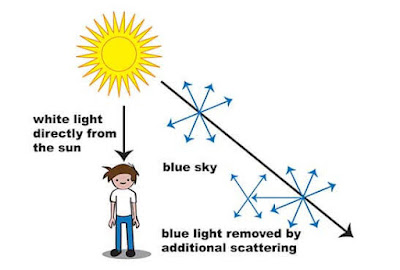- Get link
- X
- Other Apps
The sky appears blue to the human eye because of a phenomenon called Rayleigh scattering. This occurs when light from the sun, which is made up of a spectrum of colors, hits the Earth's atmosphere and is scattered in all directions.
When light travels through a medium such as air, it can interact with the particles that make up that medium, such as molecules of nitrogen and oxygen. These particles are much smaller than the wavelength of visible light, which means that they can scatter light in all directions.
When light from the sun hits the atmosphere, the shorter, blue wavelengths of light are scattered more than the longer, red wavelengths. This is because the shorter, blue wavelengths have more energy and interact more strongly with the atmospheric particles. As a result, the blue light is scattered in all directions, including towards the ground.
On a clear day, when the sun is high in the sky, the blue light is scattered throughout the entire atmosphere, reaching the ground from all directions. This is why the sky appears blue to us, regardless of which direction we're looking.
However, the color of the sky can change depending on the time of day and weather conditions. For example, during sunrise and sunset, when the sun is low on the horizon, its light must travel through more of the atmosphere before reaching the observer, causing more scattering of the light and making the sky appear red or orange. Similarly, the sky can appear gray or white during overcast days or in areas with high levels of pollution, as the light is scattered by the large number of particles in the air.
In summary, the sky appears blue due to the phenomenon of Rayleigh scattering, which occurs when light from the sun hits the Earth's atmosphere and is scattered in all directions. The shorter, blue wavelengths of light are scattered more than the longer, red wavelengths, causing the sky to appear blue to the human eye. However, the color of the sky can change depending on the time of day and weather conditions.
- Get link
- X
- Other Apps

Comments
Post a Comment